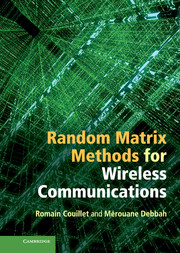Book contents
- Frontmatter
- Contents
- Preface
- Acknowledgments
- Acronyms
- Notation
- 1 Introduction
- Part I Theoretical aspects
- Part II Applications to wireless communications
- 11 Introduction to applications in telecommunications
- 12 System performance of CDMA technologies
- 13 Performance of multiple antenna systems
- 14 Rate performance in multiple access and broadcast channels
- 15 Performance of multi-cellular and relay networks
- 16 Detection
- 17 Estimation
- 18 System modeling
- 19 Perspectives
- 20 Conclusion
- References
- Index
18 - System modeling
from Part II - Applications to wireless communications
Published online by Cambridge University Press: 07 October 2011
- Frontmatter
- Contents
- Preface
- Acknowledgments
- Acronyms
- Notation
- 1 Introduction
- Part I Theoretical aspects
- Part II Applications to wireless communications
- 11 Introduction to applications in telecommunications
- 12 System performance of CDMA technologies
- 13 Performance of multiple antenna systems
- 14 Rate performance in multiple access and broadcast channels
- 15 Performance of multi-cellular and relay networks
- 16 Detection
- 17 Estimation
- 18 System modeling
- 19 Perspectives
- 20 Conclusion
- References
- Index
Summary
Channel modeling is a fundamental field of research, as all communication models that were used so far in this book as well as in the whole mobile communication literature are based on such models. These models are by definition meant to provide an adequate representation of real practical communication environments. As such, i.i.d. Gaussian channel models are meant to represent the most scattered environment possible where multiple waveforms reflecting on a large number of scattering objects add up non-coherently and independently on the receive antennas. From this point of view, the Gaussian assumption is due to a loose application of the law of large numbers. Due to the mobility of the communication devices in the propagation environment, the statistical disposition of scatterers is rather uniform, hence the i.i.d. property. This is basically the physical arguments for using Gaussian i.i.d. models, along with confirmation by field measurements. An alternative explanation for Gaussian channel models will be provided in this chapter, which accounts for a priori information available at the system modeler, rather than for physical interpretations.
However, the complexity of propagation environments call for more involved models. This is why the Kronecker model comes into play to adequately model correlations arising at either communication end, supposedly independent from one another. This is also why the Rician model is of common use, as it can take into account possible line-of-sight components in the channel, which can often be assumed of constant fading value for a rather long time period, compared to the fast varying scattering part of the channel.
- Type
- Chapter
- Information
- Random Matrix Methods for Wireless Communications , pp. 477 - 500Publisher: Cambridge University PressPrint publication year: 2011



